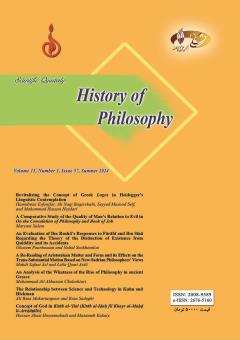Concept of God in Kitāb al-‘Ilal (Kitāb al-Iḍaḥ fil Khayr al-Maḥḍ li-Arisṭūṭālis)
Subject Areas : Geneology of philosophical schools and Ideas
Hasan Abasi Hoseinabadi
1
![]() ,
Mastaneh Kakaiy
2
,
Mastaneh Kakaiy
2
![]()
1 - Associate Professor, Islamic Philosophy and Wisdom Department, Payame Noor University, Tehran, Iran
2 - PhD in Philosophy, Allameh Tabataba’i University, Tehran, Iran
Keywords: God, Absolute Being, First Cause, Pure Goodness, Super Being, Kitāb al-‘ilal (The Book of Causes),
Abstract :
The Book of Causes (Kitāb al-‘ilal), which is also called Kitāb al-khayr al-awwal and Kitāb iḍaḥ khayr al-maḥḍ, discusses the causes of the first objects. God, as the First Cause, is one of these causes. The questions that arise here include the following: What is the concept of God in The Book of Causes? Is the God in The Book of Causes existential or beyond existential? In this book, God has been discussed while employing a number of different terms and concepts such as Absolute Being, First Cause, Pure Goodness, and Super Being. The findings of this study, which was carried out using a descriptive-analytic method, indicate that, in the view of the author of this book, God is not only Pure Existence (as opposed to limited existence) but also Pure Goodness, and His being Pure Goodness is based on existence. He is also the First Cause in the sense of the true creating efficient cause. There are also some reasons for considering Him to be existential and beyond existential. The term Super Being for God – as opposed to limited and concrete existence – refers to “existence through participation”, which applies to all creatures. Moreover, it appears that among the three terms of the First Cause, Pure Goodness, and Pure Existence, the last one is more comprehensive than others in describing God. Existence is the basis for the other two concepts, namely, the First Cause, which is an efficient and creating cause that grants existence to all things and existents, and Pure Goodness, the goodness of which is mediated by its existence.
بدوی، عبدالرحمن (1977م) «الایضاح فی الخیر المحض لأرسطوطالیس»، الفلاطونیة المحدثة عند العرب، کویت: وکالة المطبوعات.
پروکلوس (1401) مبادی الهیات، ترجمۀ امیرحسن ساکت، تهران: مؤسسۀ پژوهشی حکمت و فلسفۀ ایران.
پورجوادی، نصرالله (1399) «پرکلس»، دایرةالمعارف بزرگ اسلامی، ج 13، شمارۀ مقاله 5500.
تبرایی، مهناز؛ علمالهدی، سیدعلی (1399) «بررسی تأثیر آثار پروکلس بر مفهومسازی فارابی و ابنسینا از واجبالوجود»، فلسفۀ دین، دورۀ 17، شمارۀ 2، ص277ـ259. DOI: 10.22059/JPHT.2020.285819.1005683.
سیف، انطوان (2003م) مصطلحات الفیلسوف الکندی (بحث تحلیلی)، الجزء الأول، بیروت: دار بلال.
کاپلستون، فردریک (1375) تاریخ فلسفه، ج1: یونان و روم، ترجمۀ سیدجلالالدین مجتبوی، تهران: علمی و فرهنگی و سروش.
Adamson, P. (2002). Before essence and existence: al-Kindis conception of being. Journal of the History of Philosophy, vol. 40, no. 3, pp. 297-312. 10.1353/hph.2002.0043.
Aquinas, T. (1996). Commentary on the Book of Causes [Super Librum de Causis Expositio]. trans. by V. A. Guagliardo, Ch. R. Hess & R. C. Taylor. Washington, D.C: The Catholic University of America Press.
Bertolacci, A. (2012). A hidden hapax legomenon in Avicenna’s metaphysics: considerations on the use of Anniyya and Ayyiyya in the Ilahiyyat of the Kitab al-Sifa, Koninklijke Brill NV. pp. 289-309. https://doi.org/10.1163/9789004235083_015.
Bertolacci, A. (2022). God’s existence and essence: the Liber de Causis and school discussions in the metaphysics of Avicenna. Reading Proclus and the Book of Causes, vol. 3. pp. 251-280. Leiden: Brill. https://doi.org/10.1163/9789004501331_012.
Proclus, (1984). The book of causes. trans. by D. J. Brand. Marquette University Press.
Proclus, (1992). The elements of theology. a revised text with translation, introduction and commentary by E. R. Dodds. Oxford: the Clarendon Press.
Strauss, D. (2014). Hylozoism and hylomorphism: a lasting legacy of Greek philosophy. Phronimon, vol. 15, no. 1, pp. 32-45. doi:10.25159/2413-3086/2211.
Taylor, R. C. (1979). ST. Thomas and the Liber de Causis on the hlyomorphic composition of separate substances. Mediaeval Studies, vol. 41, pp. 506-513. DOI: 10.1484/J.MS.2.306252.


